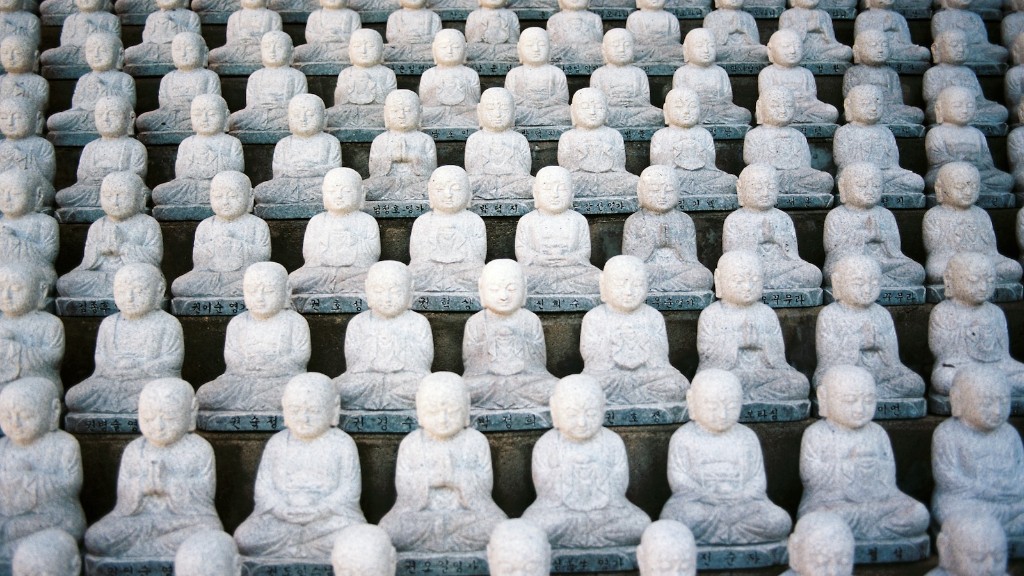Nirvana is an important concept in Hinduism that speaks to the deepest yearnings of the human soul. This philosophical concept, based on the teachings of the Vedas and Upanishads, is universally acknowledged by Hindus and non-Hindus alike as the ultimate goal of human life. Nirvana is a state of perfect bliss and peace and is often described in terms of transcending suffering, grief and attachment.
The literal meaning of the word ‘Nirvana’ is “blowing out”, or a “stilling of breath”. Popularly, it is associated with an ideal, enlightened state of being, free from the binds of the material world. It is a state of perfect contentment and oneness with the universe. The Vedic scriptures mention ‘Nirvana’ as a state of unity with Brahman or the Absolute. In Hinduism, Nirvana is seen as the ultimate goal of life, the highest and most desirable attainment. It is the end of the journey on the spiritual path, a journey that begins with the recognition of the oneness of all life.
The notion of attaining Nirvana varies based upon different denominations of Hinduism. In for example Vedanta, it is the realization of one’s true nature as well as the dissolution of individuality and distinction of the “I” or “me”. Shiva, an important god in Hinduism, is said to have achieved Nirvana upon his death and remains in a perpetual state of bliss.
According to Hindu teachings, the way to attain Nirvana is to lead a blameless life with strict moral, mental, and physical discipline. This is based on living a life free from desires and passions, and patiently striving to reach a higher state of consciousness. This requires that one remain focused on one’s duties in life and not be distracted by the material world. Leading a holy life of selfless service, spiritual practice, and devotion are also seen as important aspects of achieving Nirvana.
Furthermore, spiritual practices such as japa, meditation and chanting, selfless service, renunciation, moral discipline, and studying the scriptures are all essential methods to attain a state of Nirvana. Aspiring to liberate oneself from sorrow, fear, suffering, and ignorance are of the utmost importance in this spiritual journey.
The teachings regarding attaining Nirvana resonate with many Hindus, who strive to live a meaningful life to fundamentally attain the sought after liberation of Nirvana. Most Hindu sects remain focused on attaining this state of spiritual perfection, which is spoken about in almost all religious texts. Hindus believe that it is only when one reaches such a state does one fully recognize one’s oneness with the universe.
The Nature of Nirvana
The Vedic scriptures describe Nirvana as a state of bliss, peace, and liberation which is the goal of learning, teaching, and practice. The patient striving is what grants one access to the highest realms of joy and peace, and the ultimate state of Nirvana. It is a release from the cycle of death and rebirth, what the teachings of the Upanishads refer to as ‘Moksha’.
It is a state in which the soul is reunited with Brahman, the absolute and perfect being. In Buddhism, a similar concept known as Nibanna is described, which is a release from suffering and a reunion with the divine.
Nirvana is also symbolically represented in the Hindu scripture, the Bhagavad Gita, which states that liberation from the cycle of death and rebirth can be achieved by living a life based on virtue and seeking assistance from the divine. This message is reiterated in various Hindu scriptures, which emphasize the importance of living a holy life and being devoted to the Lord.
The State Of Perfection
Nirvana is also seen in some denominations of Hinduism as the quality of being perfect. It is a state of harmony, balance and integration and is described in the scriptures as a union of the individual soul with the universal soul and the fusion of matter and spirit.
In the Hindu conception, this is the epitome of success and the ultimate achievement in life. Achieving the qualities of compassion, wisdom, and contentment are seen as essential aspects of attaining this state of perfection and liberation. This goal is one that most Hindus strive for through the practice of yoga, meditation, and selfless service.
The concept of Nirvana is deeply embedded in Hinduism, and it has been explored and expounded upon by generations of Hindu scholars. While Nirvana may appear to be a distant and lofty ideal, it is achievable by following a disciplined spiritual path and diligent practice. Such spiritual practice leads to a deeper understanding of oneself and a union with the divine. It is a state of perfect and unending bliss.
Living a Life of Virtue
Living a life of virtue is seen as a major factor in the pursuit of Nirvana in Hinduism. The Bhagavad Gita stresses that only by leading a blameless life can one hope to attain the highest state of enlightenment and peace. This means cultivating compassionate behavior, refraining from aggressive and unwanted activities, and being kind and generous.
Scriptures such as the Bhagavad Gita, as well as the teachings of various Hindu saints and sages, emphasize the importance of following one’s Dharma, or duty in life. Doing one’s duty according to one’s beliefs, without attachment or desire, is seen as essential in achieving liberation from the cycles of birth and death.
Living a disciplined and ethical life is also important as it engenders spiritual growth and inner peace. This is essential in achieving a higher level of consciousness and spiritual realization, which is essential in attaining Nirvana.
Mentorship From Saints and Sages
Throughout history, many Hindu saints and sages have devoted their lives to helping others reach the highest spiritual attainment. They provide the guidance and inspiration that is necessary for those seeking to reach a state of Nirvana. The mentorship of such enlightened beings is essential in following a spiritual path that is not easily discernible in daily life.
The words and teachings of such enlightened beings such as Ramana Maharshi and Sri Aurobindo help to illuminate the necessary qualities that lead to the attainment of Nirvana. Such teachings provide the necessary guidance for seekers to develop a proper understanding of the inner journey and aiding them towards the highest spiritual attainment.
Although reaching the state of Nirvana requires one to fulfill many conditions and adhere to a strict spiritual routine, it can be achieved with guidance and practice. It is a state of bliss, freedom, and liberation that is spoken of in most Hindu scriptures, and it is the perfect goal of human life.
The Liberation of Nirvana
The liberation of Nirvana is an important concept in Hinduism that speaks to the greatest spiritual longing of humankind. It is the ultimate goal of spiritual practice and it is seen as a state of perfect bliss and peace. This is achieved through living a blameless life and following a strict spiritual discipline.
Living with an attitude of oneness with all of creation and remaining focused on one’s spiritual duties are essential for this liberation. Living a life of virtue and seeking the guidance of saints and sages is also important. Such practice leads to a profound understanding of oneself and the divine, paving the way to a higher level of understanding and the ultimate perfect bliss of Nirvana.
Understanding the Divine Union
Nirvana is viewed in Vedanta as the realization of one’s true nature as well as the dissolution of individuality and distinction. This is understood as the union of the individual soul with the universal soul, what some refer to as the Transcendental Consciousness, as well as the fusion of matter and spirit.
The highest attainable state of liberation is understood to be the realization of this Divine union. By maintaining a state of union with the divine, all other struggles and sufferings are seen to dissolve and the ultimate state of bliss is attained. It is this ultimate attainment of the highest spiritual liberation, referred to as Nirvana, that is seen as the ultimate goal of life.
The Path of Renunciation
Renunciation is another important aspect in the Hindu path to Nirvana. In the Hindu tradition, renunciation of the material world, as well as attachment and desires, is seen as essential in attaining the liberation of Nirvana. It is a process in which one detaches from worldly possessions and instead cultivates an attitude of selflessness. Doing so is seen as a way to bring balance and peace to the soul.
The practice of renunciation is seen as the ultimate sacrifice, in which one is willing to forego everything and abandon attachment in order to attain liberation. This path of renunciation is seen as the ultimate and most potent form of devotion and it is seen as the means to liberating the soul from worldly attachments and preparing it for the ultimate state of Nirvana.
The Eternal Bliss of Nirvana
The ultimate attainment of eternal bliss, or Nirvana, is a cherished goal of Hindus and seekers of truth and liberation. It is the highest state that can be achieved, one in which the soul is reunited with the divine and liberated from death, suffering, and the cycles of birth and rebirth. While it is not an easy goal, it is achievable through dedication, discipline and mentorship from enlightened teachers.
Attaining Nirvana requires efforts to live a blameless life, practice selfless service, and devote oneself to understanding the scriptures. It is also essential to turn one’s attentions to spiritual practices such as japa, meditation, and chanting. With such tools, one can achieve the ultimate goal of Nirvana, the perfect state of peace and bliss.




